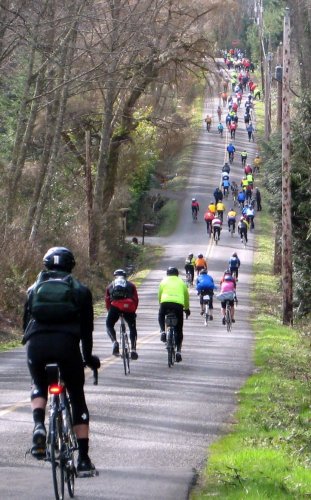 A weekend crash in British Columbia involving bicyclists and a passing car raises the safety issue of bicycle riding two or more abreast.
A weekend crash in British Columbia involving bicyclists and a passing car raises the safety issue of bicycle riding two or more abreast.
The 2008 Olympic silver medalist in the triathlon event is among a group of about 20 cyclists who could be charged with not riding single file in a crash on Vancouver Island.
A car came upon the cyclists, riding three and four abreast, crossed the yellow line, and began passing in the oncoming lane as another car pulled onto the road in that lane.
The collision knocked the passing car into the bicyclists, taking out about 15 riders. Two were taken to the hospital with non life-threatening injuries. Olympic medalist Scott Whitfield was near the front and wasn't hit.
Compact
One of the cyclists explained to a reporter at the Times Colonist that cyclists often try to ride in compact groups because they're easier and safer to pass than a long line of single-file bicycles. That's a violation of the motor vehicle act in British Columbia, however, which says bicycles must ride single file.
The car attempted to pass the group at a yellow (no passing) line, approaching an intersection at a bend in the road. That sounds like a less than ideal place to pass. Police are investigating charges against the cyclists, the driver, or both.
In US
Most states allow cyclists to ride two abreast, according to literature I've read. Most of those states, however, require that cyclists move into a single-file line when a car approaches from the rear.
Bicycle advocate John Allen's website argues in favor of side-by-side riding in most cases because it's the most practical way bicyclists can share information with one another, and it's unavoidable when bicyclists are passing each other. He continues:
“On any road where motorists can use the next lane to overtake and can see the bicyclists from far enough behind to merge around them, riding side by side inconveniences nobody and is reasonably safe. …
“Riding side by side is indeed hazardous when sight lines are limited (just past a hillcrest, or on a curving road lined with vegetation or walls). Still, under these conditions, the overtaking motorist who strikes a bicyclist was clearly exceeding a safe and reasonable speed, or inattentive.”
Single is safer
The Seattle-based Cascade Bicycle Club, however, recommends “single file is safer,” even though the state of Washington allows riding two abreast.
For motorists, Cascade says, the issue is not being able to pass cyclists easily or quickly.
“While it might take drivers longer to pass a long line of single-file cyclists, it is more difficult to pass cyclists riding two or more abreast.”
The issue is safety for bicyclists.
“… riding two abreast while going uphill means that other faster riders must ride as “third abreast” in order to pass slower riders. On narrower roads, passing as the “third abreast” means crossing the centerline, a clear danger to the rider. It also makes for hazardous conditions as car drivers go to pass bicyclists, pull out of driveways, or are oncoming.”
My general practice on riding on low-traffic roads is to pull up alongside someone to ride and watch my rearview mirror and listen for the “car back” warning if a car approaches. I always check my mirror before passing another cyclist, and stay to the right if a car is back there.
Picture above from 2008 Chilly Hilly on a two-lane road on Bainbridge Island that wasn't closed to traffic.

Recent Comments